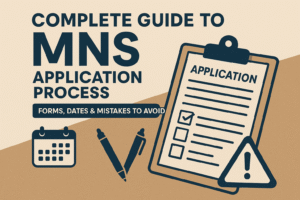Ernakulam is emerging as a focused hub for UPSC Civil Service Coaching in Kerala, where disciplined mentorship and robust test series are the two pillars that consistently convert effort into results. This guide explains how both work together, what a high-quality system looks like, and how aspirants in Ernakulam can use them to maximise scores in Prelims, Mains, and Interview.
Why Mentorship Matters More Than Material
Strategy over overload: Mentors prevent resource hoarding by locking a one-book-per-subject + three revisions plan.
Personalised roadmaps: Individual strengths/weaknesses mapped to weekly targets, not generic timetables.
Feedback loops: Structured review on answer structure, examples, and time management—impossible to self-replicate at scale.
Accountability & morale: Scheduled check-ins reduce burnout and procrastination; mentors realign you after every mock.
Exam behaviour training: How to guess, when to skip, how to triage Mains questions—taught through post-test clinics.
Ideal Mentor–Aspirant Cadence (Ernakulam Model)
Fortnightly 1:1 review (scorecard + micro-targets)
Weekly doubt clinic (GS + Optional + CSAT)
Monthly audit meet (rank progression, red/amber/green topic map)
Answer-writing studio (3–5 timed answers with on-the-spot annotation)
Interview lab (DAF drills, Kerala/Ernakulam case studies)
What Great Test Series Looks Like
UPSC fidelity: Difficulty curve mirrors UPSC; no over-the-top trivia.
Coverage discipline: PYQ-anchored papers with static + current blend; topic weightage as per exam trend.
Timing realism: Full 2-hour Prelims/3-hour Mains with OMR or strict online timers.
Analytics that teach: Accuracy, attempt mix, negative marks, topic-wise heatmap, time per question, distractor traps.
Explanations that build recall: Short, source-backed keys; “why wrong” reasoning; one-page revision sheets after each test.
Discussion classes: Post-test debriefs that convert mistakes into frameworks/diagrams you can reuse in Mains.
Prelims, Mains, CSAT — Role of Tests
Prelims (GS): Calibrate risk (attempts vs accuracy), master elimination rules, sharpen map/species/Acts recall.
CSAT: Prevent surprise eliminations; timed RC, arrangements, Venns, quick arithmetic; formula diary.
Mains: Practise structure (intro–body–way forward), compress content into 150/250 words, build diagram muscle memory.
Integrated Mentorship + Test Series Blueprint (12 Months)
Months 1–3 (Foundation)
Mentor locks booklist and weekly targets; start NCERT sweep.
1 sectional Prelims test/week; 2–3 short Mains answers/week.
CSAT baseline + skill drills (3×45 min).
Months 4–6 (Core + First Cycle)
Standard texts + 1 sectional + 1 mixed Prelims test/week.
Weekly Mains mini-test (3Q × 10 marks); annotated feedback in 72 hrs.
Optional chosen (popular locally: Public Administration, Geography); topic map approved by mentor.
Months 7–9 (Prelims Intensive)
2 Prelims GS mocks/week + 1 CSAT full test/fortnight.
Mentor uses analytics to push red → amber topics; elimination drills.
Maintain 1 Mains answer/day to keep writing muscle.
Months 10–12 (Mains Ramp-Up + Interview Start)
1 full GS paper/week, 1 essay/week, optional PYQs.
Mentor rubric: Structure 10 | Content 15 | Examples/Data 10 | Presentation 10 | Way-Forward 5.
DAF worksheet + Ernakulam/ Kerala case studies (Kochi Water Metro, port-led development, waste management, coastal resilience).
Ernakulam Advantage: How Local Ecosystem Boosts Both
Experienced faculty benches for GS and optionals (notably Geography & Public Administration).
Test-discussion culture across institutes—dense post-test clinics with Kerala-relevant examples for value-addition.
Libraries & peer nets around MG Road, Kaloor, Vyttila for long sittings and daily answer labs.
Affordable Fee structures with transparent inclusions (tests, copy-checking, interview boards).
How to Evaluate Mentorship Quality (Checklist)
Named mentor with fixed fortnightly 1:1 slots.
Written Improvement Plan after every test cycle.
Copy-checked Mains answers with actionable comments (not just marks).
Doubt resolution turnaround ≤48–72 hours.
Trackable dashboards: attempt/accuracy graphs, topic heatmaps.
How to Evaluate a Test Series (Checklist)
Shows blueprint mapping to PYQs and weightage trends.
Detailed keys + sources; traps explained, not merely answers.
Strict timing + post-test discussion classes.
Includes CSAT diagnostics and targeted drills.
Transparent schedule, no last-minute paper swaps.
Sample Weekly Cadence (In-Course)
Mon–Thu: 2 GS study blocks + 1h CA integration + 30m CSAT/maps
Fri: AWP lab (3 questions, timed) + mentor micro-review
Sat: Prelims mock (2h) + analysis (1h) + error sheet update
Sun: Optional (3–4h) + essay alternate weeks + planning meet
Common Pitfalls and Mentor Fixes
Over-attempting Prelims: Mentor sets a personalised “safe attempt band” (e.g., 78–86) based on accuracy trend.
Bloated answers: Enforce 3-subheading rule + one diagram per 10-marker.
CSAT neglect: Non-negotiable 3 sets/month; RC timing benchmarks.
Note sprawl: Single master notebook + digital index; micro-notes only from mistakes.
Metrics That Predict Success
Prelims: ≥75–80% accuracy on 35–45 quality mocks; stable attempt band; falling negative marks.
Mains: 8–12 full papers with rubric scores trending upward; visible improvement in intros/way-forward; diagram density ≥1 per answer.
CSAT: ≥90–100 raw marks on recent-style papers.
Interview: DAF defence practice; Kerala data points ready; 3–5 mock boards.
FAQ (Ernakulam-Focused)
Do I really need a mentor if I have good materials?
Yes—materials don’t fix behaviour; mentors engineer exam behaviour through targeted feedback and accountability.
How many mocks are enough?
Prelims 40–60, CSAT 12–15, Mains 8–12 full papers + daily/weekly AWP.
Which optionals have strong mentorship locally?
Commonly Public Administration and Geography; always verify through sample classes and evaluated copies.






